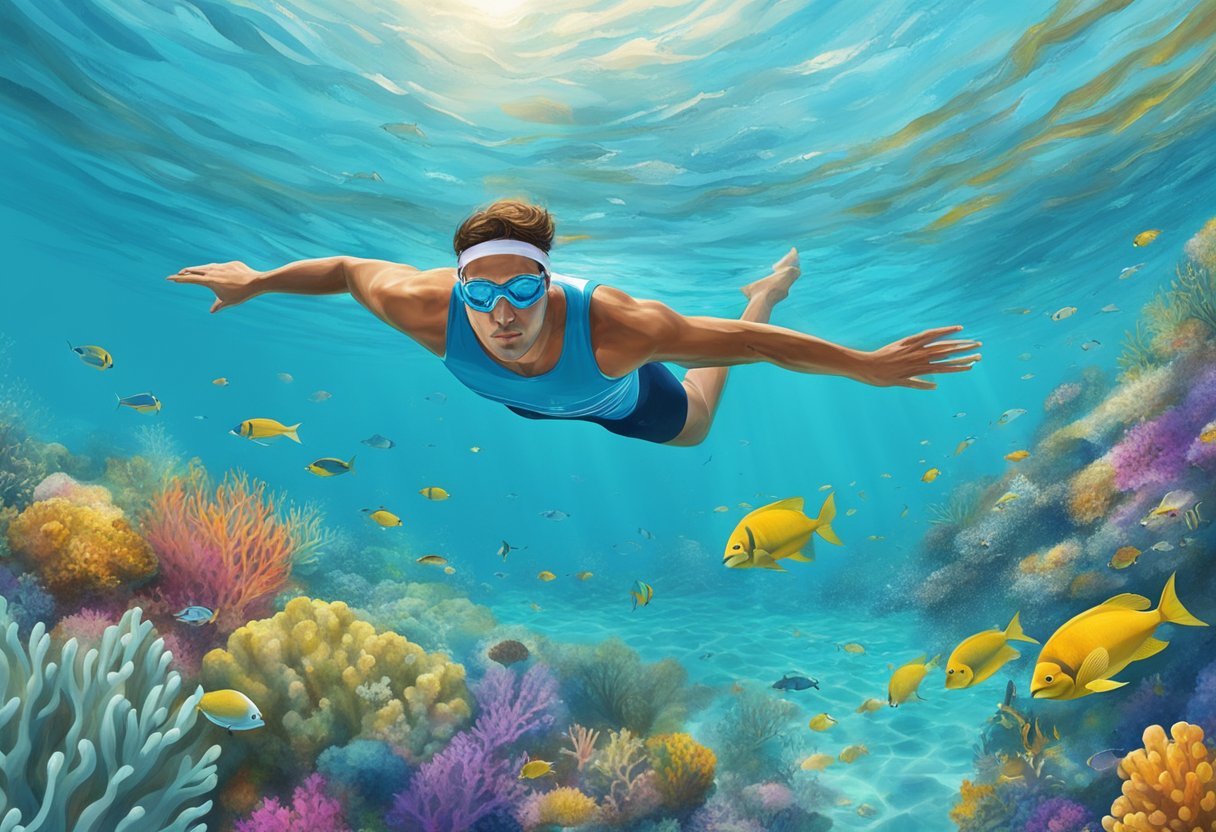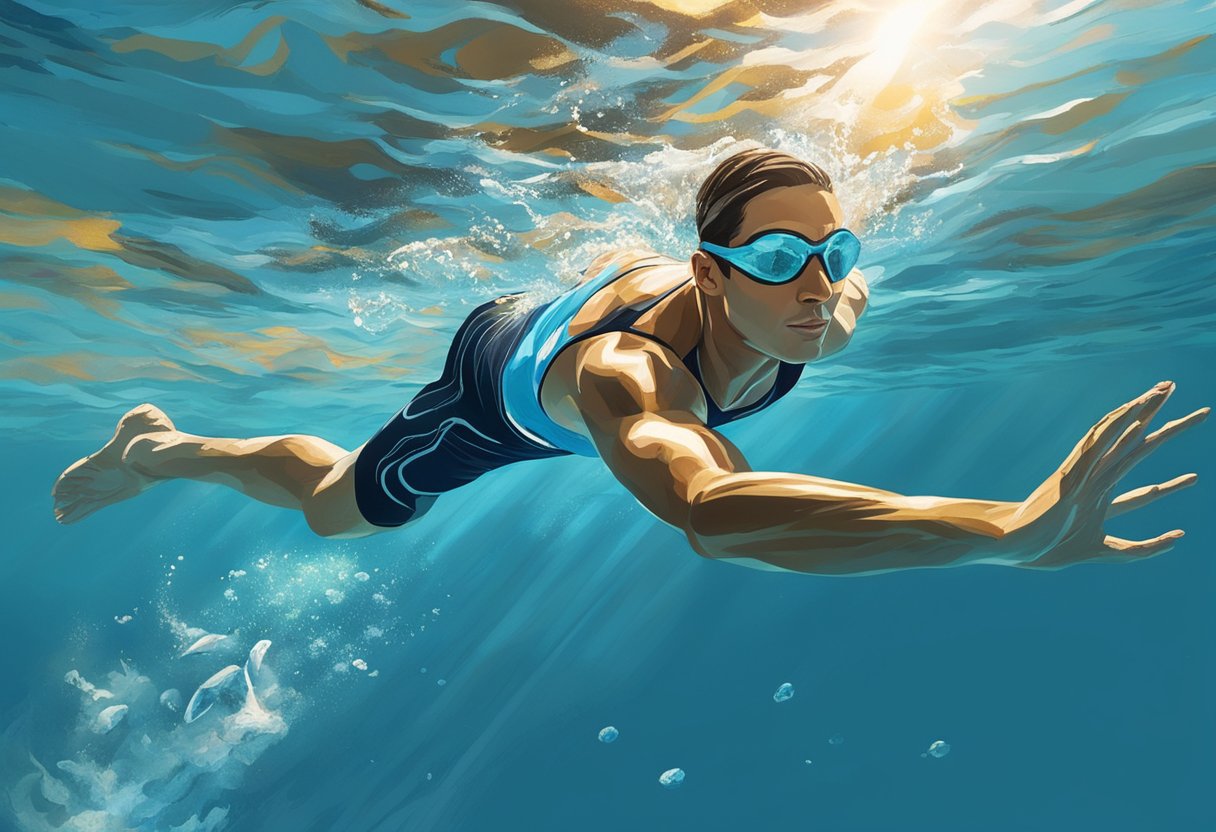Swimming in the Mediterranean offers a unique combination of exercise and relaxation, enticing fitness enthusiasts and swimmers worldwide. The Mediterranean Sea, known for its clear, calm warm waters, is an ideal setting for swimming. With its vast coastline touching Europe, Asia, and Africa, it presents a variety of swimming experiences from tranquil beachfronts to rugged coves. This region does not only provide a scenic backdrop but also the opportunity to engage in a form of exercise that benefits cardiovascular health, muscle strength, and overall flexibility.

The gentle resistance of water makes swimming a low-impact workout suitable for individuals of all fitness levels, including those with joint concerns or injuries. Additionally, swimming complements a gluten-free Mediterranean diet, a lifestyle choice gaining popularity due to its health benefits, by assisting in weight management and improving body composition. Whether you’re engaging in freestyle, backstroke, or other swimming techniques, incorporating this activity into your exercise routine can lead to improved health outcomes and enjoyment.
Key Takeaways
- Swimming in the Mediterranean pairs well with a gluten-free diet for health and exercise.
- It offers a low-impact workout that improves cardiovascular and muscle strength.
- The Mediterranean region provides a diverse range of swimming experiences for all levels.
Table of Contents
Benefits of Swimming as Exercise

Swimming in the Mediterranean provides a multitude of health benefits, ranging from improved cardiovascular fitness to enhanced mental well-being, all within the low-impact, resistance-rich environment of the water.
Cardiovascular Fitness and Heart Health
Swimming is a superb cardio workout that stimulates the heart and helps maintain healthy arteries and blood pressure, playing a vital role in promoting cardiovascular fitness. Regular swimming can lead to better heart health by strengthening the heart muscle, thereby enhancing its efficiency in pumping blood throughout the body.
Muscle Strength and Tone
The resistance of water makes swimming an excellent exercise for building muscle strength and improving muscle tone. It engages multiple muscle groups, including the core, shoulders, hips, and glutes, providing a full-body workout that strengthens and tones without putting undue stress on the joints.
Flexibility and Coordination
The rhythmic nature of swimming movements can improve flexibility and coordination. Each stroke requires a range of motion that helps loosen and stretch the body’s muscles from the shoulders to the hips, contributing to overall flexibility, while coordinating breathing with strokes enhances body coordination.
Weight Management
As a calorie-burning exercise, swimming is effective for managing body weight and reducing body fat. The act of swimming burns a significant amount of calories, which can help lower BMI and combat obesity when combined with a healthy diet, such as a gluten-free Mediterranean diet.
Mental and Emotional Well-Being
Swimming not only benefits the body but also the mind. It is known to reduce stress levels and promote mental health. The calming effect of water contributes to a sense of enjoyment and can improve brain health and sleep quality, making it a holistic form of exercise for mental and emotional well-being.
Understanding Swimming Techniques

Mastering various swimming techniques is essential for both recreational swimmers and competitive athletes. It involves understanding and perfecting different styles and strokes, optimizing breathing for efficiency, utilizing the appropriate gear, and often seeking professional guidance to improve performance and safety.
Styles and Strokes
Each swimming stroke offers a unique combination of movements that engage various muscle groups. The freestyle is popular for its speed and efficiency, utilizing alternating arm movements and a flutter kick. Breaststroke requires simultaneous arm movements and a frog kick, working both the upper and lower body. The backstroke is performed on the back, with an alternating arm stroke and flutter kick, promoting good posture and engaging the back muscles. The butterfly is one of the most demanding strokes, with simultaneous arm movement and a dolphin kick, requiring great strength and timing.
Breathing and Efficiency
Breathing technique is crucial for swimming endurance and efficiency. Swimmers must coordinate their breath with their strokes, typically inhaling quickly and exhaling underwater to maintain a consistent oxygen flow to the lungs. Proper breathing technique can prevent fatigue and ensure the swimmer’s body remains aligned and reduces resistance in the water.
Swim Gear and Equipment
The right equipment can enhance a swimmer’s experience and performance. A well-fitted swimsuit reduces drag, while goggles protect the eyes from chlorine and improve visibility underwater. Fins can aid in developing leg strength and improving kick technique, while a kickboard can help focus on leg work and build endurance without the arm movements. These pieces of gear should complement the swimmer’s technique and training.
Professional Guidance
For those looking to make significant progress in their swimming abilities, working with a coach or enrolling in swimming lessons can be invaluable. Professional guidance helps in refining proper technique, reducing the chance of injury, and providing personalized swim training strategies. A coach can offer feedback on stroke efficiency, breathing methods, and proper form, which are fundamental for competitive swimming success.
Comparing Swimming with Other Exercises

When evaluating different types of exercises, it’s essential to consider their impact level, aerobic and anaerobic benefits, and overall effects on health. Swimming in the Mediterranean provides a harmonious blend of these elements, making it a highly beneficial workout choice.
Low-Impact vs. High-Impact
Swimming is a low-impact exercise, meaning it is gentler on the body and particularly favorable for individuals with joint pain or osteoarthritis. In contrast, running is a high-impact activity that can place significant stress on joints, possibly leading to discomfort or injury. Cycling falls between these two, with a lower impact than running but higher than swimming, making it a balanced option for those seeking a moderate impact workout.
Aerobic Versatility
Aerobic exercise, also known as cardio, is vital for cardiovascular health. Swimming is an excellent form of cardio exercise, effectively raising the heart rate to burn calories and improve heart health. It offers the versatility of being both a moderate and a vigorous workout, depending on the intensity. Running is comparable in aerobic capacity, often burning more calories at a quicker pace. Cycling also offers aerobic benefits, allowing for extended workout periods due to its lower impact nature.
Anaerobic Contributions
Anaerobic exercise involves short bursts of intense activity, contributing to muscle strength and power. Swimming allows for anaerobic contributions through sprints and resistance training within the water. It serves as both a full-body workout and a strength training activity, utilizing almost every muscle group. Running and cycling, while providing opportunities for anaerobic workouts, typically concentrate on the lower body, giving swimming an advantage in total body conditioning.
Health Considerations and Swimming

Swimming in the Mediterranean is not only a refreshing activity but also offers numerous health benefits. However, individuals need to consider personal physical conditions and understand safe practices to maximize the benefits and minimize risks.
Physical Conditions and Limitations
Swimming is an excellent exercise for enhancing cardiovascular health and improving muscle strength. It has a low-impact nature, making it suitable for those with arthritis or joint problems. Swimming can also contribute to maintaining or increasing bone density, since resistance-based activities promote bone health. However, those with certain conditions such as hypertension or a lung condition like asthma should consult with healthcare providers before engaging in swimming. This is crucial especially when dealing with saltwater and potential allergens present in the natural open water of the Mediterranean.
Safe Practice in Water
Safety in the water is paramount for ensuring a positive swimming experience. Here are some guidelines for safe practice:
- Monitor Water Conditions: Always check weather forecasts and water conditions before swimming in the Mediterranean.
- Understand Your Limits: Swim within your abilities and avoid overexertion, which can lead to exhaustion or increase the risk of drowning.
- Use of Chlorinated Pools: If opting for chlorinated pools, be aware of the potential impact of chlorine if you have a skin or respiratory sensitivity.
- Open Water Safety: When swimming in open waters, be aware of currents and marine life, and always swim where lifeguards are present.
Incorporating safe swimming practices is essential for recovery and long-term joint health benefits, especially in the buoyant Mediterranean waters.
Cultural and Recreational Aspects

The Mediterranean region is rich in culture and provides ample opportunities for both competitive and recreational swimming. These activities not only serve as exercise but also play a significant role in the lifestyle and well-being of individuals in this area.
Swimming in the Mediterranean
The Mediterranean is known for its crystal-clear waters, making it a premier destination for those seeking enjoyment and leisure through swimming. Places like the Scala dei Turchi in Sicily offer breathtaking spots for a leisurely swim, with the unique limestone formations adding to the cultural experience. In Europe, swimming serves as a bridge between the bustling life on land and the serenity of the sea. Countries like Turkey and France have coastlines that invite locals and tourists alike to immerse themselves in the water as part of their daily recreation.
Competitive Swimming Events
Europe has a storied history of competitive swimming, with events often making their way to the global stage, such as the Olympics. Competitive swimming in the Mediterranean includes open-water races, which have become signature cultural events, highlighting the region’s passion for water sports. These events not only showcase athletes’ dedication but also the communal spirit as spectators gather to celebrate these traditions.
Psychological Benefits of Exercise
Swimming is widely recognized for offering multiple psychological benefits, serving as a form of exercise that can enhance mental health, boost memory, and provide stress relief. The act of swimming itself is therapeutic, allowing for a mental respite from the daily grind. In the context of the Mediterranean lifestyle, swimming is a holistic exercise, granting both the body and the mind a moment of tranquility amidst the scenic backdrop of the sea.
Practical Information for Swimmers

Before diving into the Mediterranean’s alluring waters, swimmers should consider several practical aspects, ranging from mastering the basics to understanding the costs involved. This section provides essential information to ensure a safe and enjoyable experience for swimmers of all ages and skill levels.
Learning How to Swim
How to Swim: For those looking to learn how to swim, the Mediterranean Sea offers a unique opportunity with its calm and crystal-clear waters. Proper Technique is crucial for efficiency and safety; beginners should seek instruction from qualified professionals to master stroke mechanics and breathing strategies.
Swimming for Different Age Groups
Children: The Mediterranean is an excellent place for young swimmers to enjoy water activities. It is imperative to ensure that children are supervised and swim within designated safe zones. Elderly: Aquatic exercise is beneficial for older adults, providing a low-impact exercise adapted to their needs, helping to maintain flexibility and cardiovascular health.
Costs and Accessibility
- Membership Fees: Some Mediterranean beach areas might require membership fees for access to private beaches and facilities.
- Public Pools: For those who prefer swimming in pools, there are public options that offer affordable access.
- Cost: Entrance to many Mediterranean beaches is free, though certain amenities such as sunbeds or parasols may incur additional charges.
Each swimmer’s journey and needs are unique, but careful consideration of these practical information points can enhance the swimming experience in the beautiful Mediterranean environment.
An Overview of Swimming Research

Recent studies have shed light on the multifaceted benefits of swimming, particularly highlighting its impact on various health parameters. Researchers have systematically investigated how this aquatic activity influences the human body, paving the way for a robust understanding of its holistic benefits.
Cardiovascular Health:
A 2016 study outlined the positive effects of regular swimming exercise on cardiovascular health, especially noting improvements in blood lipid profiles among middle-aged women. Such findings have significant implications for heart health and disease prevention strategies.
Metabolic Syndrome:
Swimming has been posited as a beneficial exercise for managing conditions such as type 2 diabetes and obesity. A piece from PMC7938372 recognized swimming as a practical, non-pharmacological approach to improving metabolic syndrome risk factors.
Mental Health:
Moving onto mental well-being, an extensive review in a ScienceDirect article mentioned that leisure swimmers reported higher overall mental health compared to competitive swimmers, suggesting the therapeutic nature of aquatic exercises.
Academic Perspectives:
Hirofumi Tanaka, a notable figure in the field of kinesiology at the University of Texas, and experts from Harvard Medical School have both emphasized swimming’s role in a well-rounded fitness regimen. Their contributions have established an evidence-based context for swimming research and its practical applications.
By understanding the comprehensive research landscape surrounding swimming, individuals can better appreciate this exercise form. It is not just a recreational pastime but also a key component in maintaining physical and mental health.
Frequently Asked Questions

Swimming in the Mediterranean is a popular exercise with numerous benefits. Visitors often have questions about its impact on health and well-being.
What are the mental health benefits of swimming in the ocean?
Swimming in the ocean can lead to significant improvements in mental health. The combination of natural beauty and physical activity helps release endorphins, reducing stress and enhancing mood.
How does swimming in the sea affect skin health?
The sea’s saltwater has natural minerals that can benefit skin health. Regular swims can help exfoliate the skin and may improve conditions like eczema and psoriasis.
Can swimming in the ocean have detoxifying effects on the body?
Swimming is an excellent form of cardiovascular exercise. Ocean swimming in particular stimulates circulation, which aids in the body’s natural detoxification processes by promoting lymph flow.
What are the physical health benefits of swimming in the sea?
The sea provides a challenging environment for swimming, promoting cardiovascular health and muscle strengthening without the impact stress of land-based activities.
How does morning swimming in the Mediterranean influence overall well-being?
Morning swims in the Mediterranean can energize swimmers for the day ahead. This exercise can enhance circadian rhythms, promoting better sleep and alertness during the day.
What spiritual enhancements can be experienced from ocean swimming?
For many, ocean swimming can be a meditative and transformative experience. It allows individuals to feel a sense of connection with nature, which can lead to spiritual growth and rejuvenation.



